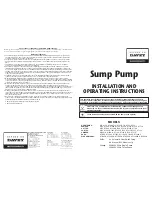
RT-SVX056D-GB
24
Installation
Supply fan Airflow measurement option
The airflow measurement option when selected is
associated with an air differential pressure sensor which
measures the pressure difference before the inlet nozzle
and inside the inlet nozzle.
Unit air flow can be calculated on the basis of the
differential pressure (difference in pressure of the static
pressures) in keeping with the following equation:
Qv in [m3/h] and
∆
p in [Pa]
N number of fans
k takes into account the specific nozzle characteristics.
Connection on the unit side is accomplished via a pre-
mounted T tube connector. This tube connector is suited
for pneumatic hoses with an internal diameter of 4 mm.
k factors:
Fan diameter
400
450
500
k-factor
188
240
281
According to the option chosen, airflow or fan RPM can
be read directly on the optional display or should be
determined by connecting a pressure drop meter to the
pre mounted T connector.
Setup is -20%/+30% variation versus factory setting
(190m3h-1/kW @ 250 Pa).
Gas Pipework Installation
Installation of gas piping (to be performed
by the contractor)
The installation rules for public buildings shall be
followed: refer to the brochure in the “Journal Officiel”
number 1477-1 (France only).
The gas supply piping and the gas stop valve shall be
dimensioned to guarantee the gas supply pressure at the
unit’s inlet when it is functioning at full capacity.
It is recommended to install one expansion valve as
close as possible to each installed unit. The piping must
be self-supporting before the final branch connection
to the unit. Allow for a dust trap (filter) upstream of the
connection to the unit. Search for gas pipe leaks using
tensio-active product such as “Teepol” or “1000 bulles”
or another equivalent method. Soapy water must not be
used.
WARNING!
Never use a flame to search for leaks. The required gas
pressures at the unit’s inlet connection are specified
in table «Marking Category of gas section in different
countries»
CAUTION!
The piping must not exert any stress on the branch
connection to the burner.
The heating system must be isolated by the gas stop
valve on the gas supply piping during the pressure tests,
as soon as the pressure exceeds 0.060 bar (60 mbar).
If pressure greater than 0.060 bar is applied to the gas
valve inlet the unit may be damaged. In this case it is
mandatory to add a pressure reducer.
Connect condensation pipe for modulating burner.
2 stages burner is not supposed produce condensate
and the small amount of condensate possibly produced
in particular working conditions will in case evaporate
Figure 12 - Typical Gas Supply pipework
KEY
1
Main burner gas solenoid valve
2
Pilot burner gas solenoid valve
3
Pressure stabiliser
4
Safety gas solenoid valve
5
Gas filter (small section)
6
Anti-vibration joint
7
Gas filter (large section)
8
Gas valve
















































